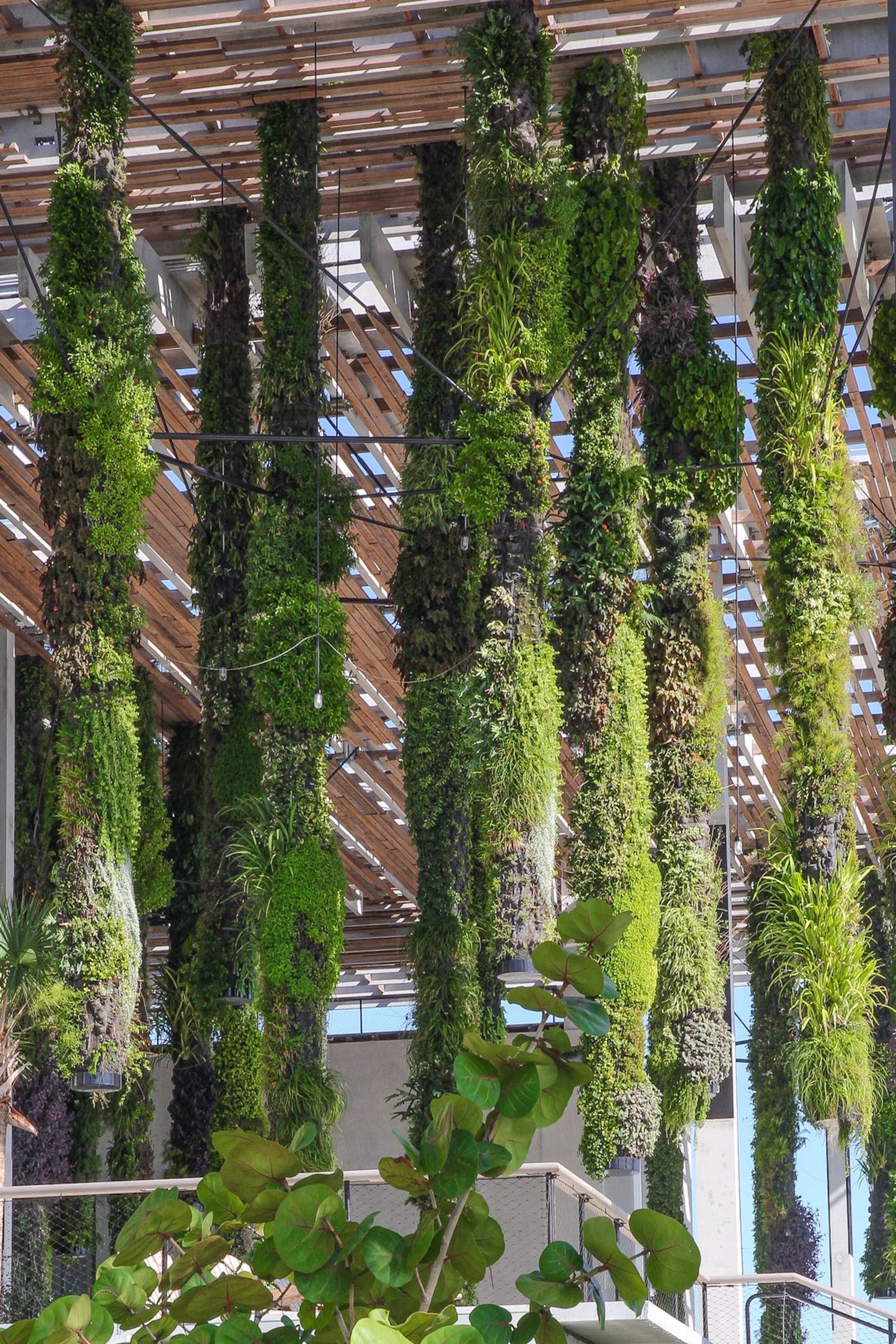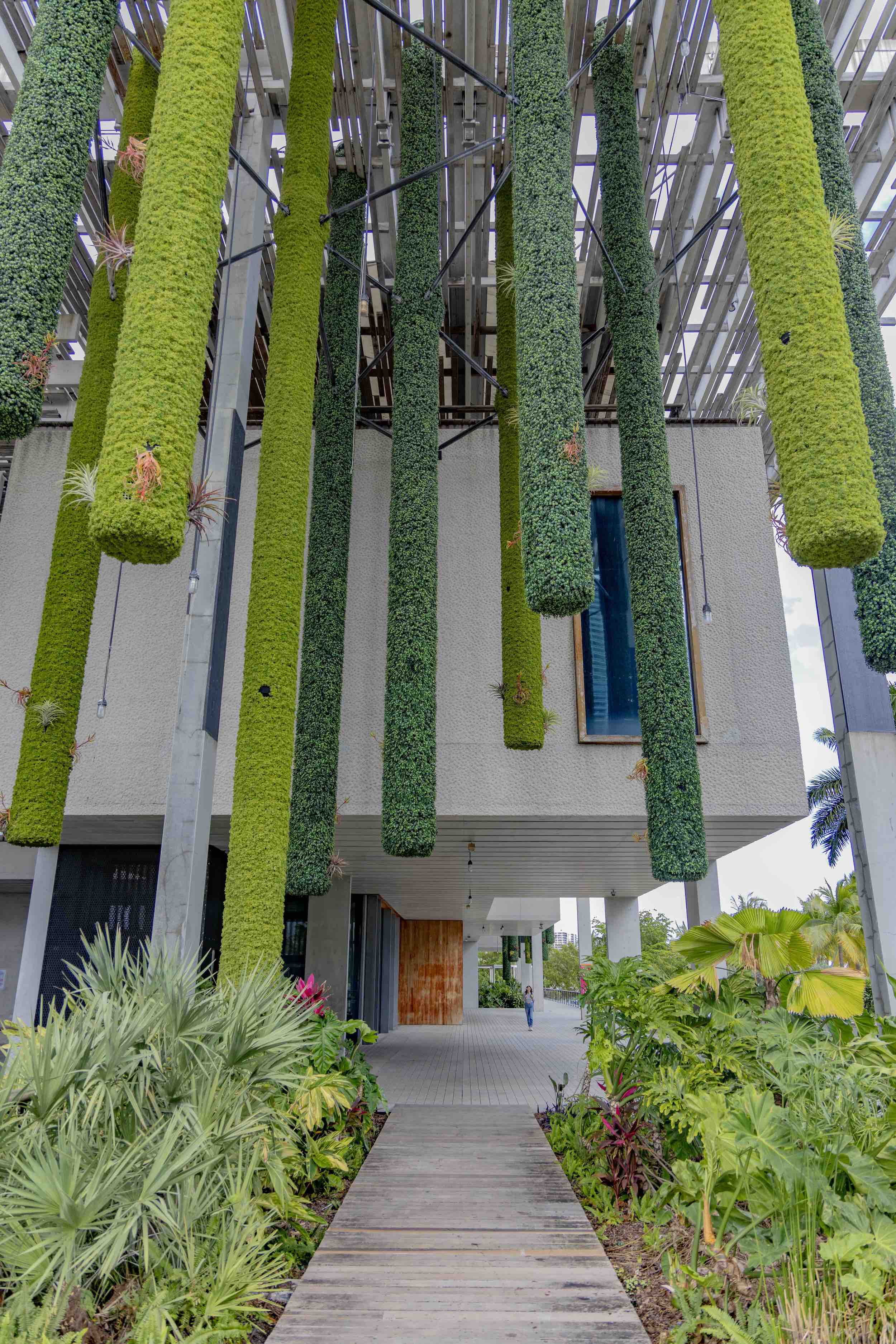When the Pérez Art Museum Miami (PAMM) opened in December 2013 it welcomed visitors with terraces shaded from the subtropical sun by an expansive, pergola-like roof dripping with vegetation. Designed by Herzog & de Meuron, the 200,000-square-foot building offered outdoor spaces on all four sides and alluring views of Biscayne Bay. “It doesn’t really have a form,” said Jacques Herzog about the building in a 2013 RECORD article. “It’s more about permeability . . . We wanted to do something that shows the potential in this city to let in sun and vegetation.” A much-discussed feature of the roof were its suspended columns of plants created by French botanist Patrick Blanc, the pioneer of vertical garden design.
Now those installations of diverse botanical species—spiraling around tall cylinders floating above visitors as they enter and exit the museum—are gone. While the cylinders are still there, they’re wrapped with mostly uniform plastic turf with a few real orchids clinging on. After a series of troubles maintaining the plants, PAMM started replacing them in August 2022 and completed all 67 columns by fall 2023.

1

2
The suspended gardens at the museum pictured in August 2014 (1) and following the recent switch to mostly artificial vegetation (2). Photo by Daniel Azoulay Photography (1), courtesy PAMM (2)
“The hanging gardens have been an integral example of PAMM’s connection to our environment since their growth in 2013,” said Mark Rosenblum, the museum’s chief operating officer in a written statement to RECORD. “The recent updates to the gardens incorporate a hybrid solution of artificial moss and ivy with living plants. The hanging gardens in their original fully living form, unfortunately, require a level of upkeep and cost that is not sustainable in the long term, and these updates will preserve the gardens’ original relationship with both nature and art while securing their long-term self-sufficiency and preservation,” added Rosenblum.
According to Herzog & de Meuron and Blanc, switching to mostly artificial greenery was unnecessary. “For the first five, six, seven years after the museum opened, the plants were okay,” said Christine Binswanger, the Herzog & de Meuron partner in charge of the project. “They were not always as lush as we had imagined, but they were fine.”
Around 2018, some cylinders started dripping and the architects worked with the museum to find solutions. “Having plants grow in this form is difficult,” admitted Binswanger. The architects and Blanc developed a system that used tubes and pumps to direct water to where it was needed. Some pumps did not always work properly, so water occasionally collected at the base of the cylinder. Water trickling down to flower beds on the terrace was fine, but some cylinders hung above paved surfaces, creating a problem. Blanc suggested installing porous paving in those places, but that was not done.
According to Blanc, a new maintenance crew began tending to the hanging gardens around 2018 and the plantings suffered. “Every garden needs care,” said Binswanger. “The maintenance regime has to be right and there needs to be a certain amount of love.”
“This building is all about the relationship between architecture and nature,” explained Binswanger. “The plants are an important part of that. If you strip them off, the building becomes a brutal ruin. Without the plants, the roof is too monumental,” she added. “I know they love their building,” she said of the museum administrators, “but they’ve compromised the experience.”
Blanc’s original hanging gardens featured nearly 80 different plant species with each suspended column having its own composition of growing elements. “There was diversity, but unity,” said Blanc. “Everything worked together to create a natural system” that filtered and cooled the air underneath, reduced humidity, and attracted birds and insects. He hasn’t seen the new installation in person, but Blanc reacted to recent photographs by saying, “It’s terrible. It’s all small, flat leaves without any complexity. They might as well have just painted the columns green.”
Both Binswanger and Blanc said they were not consulted about the alterations to the hanging gardens, but would be happy to work with PAMM to develop a better solution to the problem.



Post a comment to this article
Report Abusive Comment